



Aeromedical Services Supporting South African National Health Strategic Objectives Rod Bennett Hexor 14 March 2012
Disclaimer • This presentation is not a description of South African National Health Policy • This is an analysis of the potential of aeromedical services to respond to the National Health Department’s declared strategic plan. • Although the proposal describes full national coverage, it does not describe the full potential of aeromedical services in South Africa
The Concept • A comprehensive, fully integrated and coordinated national emergency, rescue and outreach service . – Fixed wing, rotary wing and no wing – Day and night, all terrain – Public and private sector – One service, one call centre – Everyone in South Africa
Strategic objectives • EMRS: Anyone, anywhere, any time; 1 hour max from call to first specialised care. • NHI: Full public-private integration of EMS, rescue, hospital transfers and flying doctor services • Transformation of Primary care: Anyone, anywhere, full access to family health teams • MDG: Reduction of avoidable maternal and child deaths
Headlines • Massive air sea search for 2 fisherman off Cape coast • Navy winchman given award for bravery winching 22 to safety off sinking ship after tornado • Horse rider airlifted to hospital (Hillcrest)
Delivery “options” • Do they have the same rights?
This makes the difference ….
Coverage in 1 hour Helicopter 205 kms/hr 132,043 sq kms One helicopter = 23 ambulances Road ambulance Average 60 kms/hr Not straight line 5,686 sq kms
The coverage challenge This means that 8 % of the population occupies 94 % of the country
Integration and Coordination Aircraft cover the spaces where population density is too low Ambulances based in communities where population density is high Balance demand to optimise efficiency
Existing bases and coverage
Proposed bases and coverage
6 service areas • Emergency retrievals (remote areas) • Maternal and child health emergency response (all areas) • Inter hospital transfers • Clinical outreach (flying doctors) • Rescue (extrication before treatment) • Risk management (disaster response)
One call centre • All emergency calls • All transfer requests • Response determined by protocol – Predetermined geography for air and land response – Predetermined response to maternal and child incidents • Coordinated major event or disaster response • No postcode lottery
Every Community • Elected community health workers provide access to service in remoter areas • First aid training ensures no green code calls • On site team for control of landing • Linked to transformation of primary care service delivery structure
Transformation of PHC
Benefits • Creation of a national resource integrating public and private provision but retaining government oversight and governance. • Optimal (efficient and economical) use of scarce financial, human and capital resources. • Improved outcomes and lives saved, particularly for vulnerable groups (maternal and child mortality reduction). • Improved (and equitable) access to services for the whole population. • Improved public perception of government capacity and response to needs of rural and poor populations. • Full coverage of the population within appropriate timescales (40 to 60 minutes) for emergencies
Benefits, cont … • Full coverage of targeted (lower 2 quintile) schools with family health services, significantly in deep rural areas. • Logistics system for mentoring, monitoring and supervision of decentralised District Specialist Health Teams. • Coordinated cross (provincial) boundary service for inter hospital transfers, with tertiary services utilised as a national resource. • Single national call centre coordinating provincial, GEMS and private sector emergencies. • Reduction of duplication of coverage and uniform coverage for whole country.
Benefits, cont …. • Ability to construct single tariff scale for management of service available to the whole population. • Outreach of specialised services available to whole population, even in remote rural areas. • Reduction in admissions through improved management of patients in PHC. • Reduction in waiting lists through targeted intervention at local level by specialists operating outreach services. • Reduced costs to patients to receive care as it will be decentralised and supported by outreach services.
Benefits, cont …. • Improved opportunity to implement task shifting by enabling mentoring, monitoring and supervision at local level even in deep rural areas. • Reduction in road accidents rate for ambulances because of reduced numbers, reduced travel distances and tiredness of crews. • Coordinated, rapid national resource for risk management and response to major incidents and disasters. • Capacity to respond to emergencies at night and over adverse terrain across the entire country. • Increased utilisation will also reduce skills degradation and adverse consequences of boredom
Conclusions • Achieves significant national objectives • Directly in step with national policy • Based on a working and efficient service platform with years of management experience (AMS) • A true public-NGO-private partnership
… and the cost? If aeromedical services can replace the most inefficient 12% of road ambulances in deep rural areas it will be cost neutral
Recommend
More recommend